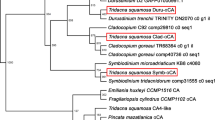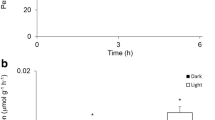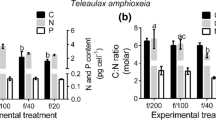Abstract
The mechanism whereby inorganic carbon (Ci) is acquired by the symbiotic association between the giant clam (Tridacna derasa) and zooxanthellae (Symbiodinium sp.) has been investigated. Ci in the haemolymph of the clam is in equilibrium with the surrounding sea water. The photosynthesis rate exhibited by the intact clam varies as a function of the Ci concentration in the clam haemolymph. The gill tissue contains high carbonic anhydrase activity which may be important in adjusting the Ci equilibrium between haemolymph and sea water. Zooxanthellae (Symbiodinium sp.) isolated from the clam mantle prefer CO2 to HCO -3 as a source of inorganic carbon. The zooxanthellae have low levels of carbonic anhydrase on the external surface of the cell; however, mantle extracts display high carbonic anhydrase activity. Carbonic anhydrase is absent from the mantle of aposymbiotic clams (T. gigas), indicating that this enzyme may be essential to the symbiosis. The enzyme is probably associated with the zooxanthellae tubes in the mantle. The results indicate that carbonic anhydrase plays an important role in the supply of carbon dioxide within the clam symbiosis.
Similar content being viewed by others
Literature cited
Abe, T., Tsuzuki, M., Miyachi, S. (1987). Transport and fixation of inorganic carbon during photosynthesis of Anabaena grown under ordinary air. I. Active species of inorganic carbon utilised for photosynthesis. Pl. Cell Physiol., Tokyo 28: 273–281
Asada, K. (1982). Biological carboxylations. In: Inoue, S., Yamazaki, N. (eds.) Organic and bio-organic chemistry of carbon dioxide. John Wiley, New York, p. 185–251
Bradford, M. M. (1976). A rapid and sensitive method for the quantitation of microgram quantities of protein utilising the principle of protein-dye binding. Analyt. Biochem. 72: 248–254
Fitt, W. K., Rees, T. A. V., Yellowlees, D. (1993). The role of haemolymph in the uptake of dissolved nitrogen in the zooxanthellae symbiosis with the giant clam Tridacna gigas. (in preparation)
Graham, D., Reed, M. L., Patterson, B. D., Hockley, D. G., Dwyer, M. R. (1984). Chemical properties, distribution, and physiology of plant and algal carbonic anhydrases. Ann. N. Y. Acad. Sci. 429: 222–237
Graham, D., Smillie, R. M. (1976). Carbonate anhydrase in marine organisms of the Great Barrier Reef. Aust. J. Pl. Physiol. 3: 113–119
Imamura, M., Tzuzuki, M., Hogetsu, D., Miyachi, S. (1981). Role of carbonic anhydrase in algal photosynthesis. In: Akoyunogiou, G. (ed.) Photosynthesis, IV. Regulation of carbon metabolism. Balaban International Science Services, Philadelphia, p. 471–482
Jeffrey, S. W., Humphrey, G. F. (1975). New spectrophotometric equations for determining chlorophylls a, b, c 1, and c 2 in higher plants, algae and natural phytoplankton. Biochem. Physiol. Pfl. 167: 191–194
Mansour, K. (1946). Communication between the dorsal edge of the mantle and the stomach of Tridacna. Nature, Lond. 157: p. 844
Miyachi, S., Tsuzuki, M., Avramova, T. (1983). Utilisation of inorganic carbon for photosynthesis in various species of Chlorella. Pl. Cell Physiol., Tokyo 24: 441–451
Moroney, J. V., Husic, H. D., Tolbert, N. E. (1985). Effect of carbonic anhydrase inhibitors on inorganic carbon accumulation by Chlamydomonas reinhardtii. Pl. Physiol. 79: 177–183
Norton, J. H., Shepherd, M. A., Long, H. M., Fitt, W. K. (1993). The zooxanthellae tube system in the giant clam. Biol. Bull. mar. biol. Lab., Woods Hole (in press)
rees, T. A. V., Fitt, W. K., Baillie, B., Yellowlees, D. (1993). A method for temporal measurement of haemolymph composition in the giant clam symbiosis and its application to glucose and glycerol levels during a diel cycle. Limnol. Oceanogr. (in press)
Streamer, M., McNeil, Y. R., Yellowlees, D. (1993). Photosynthetic carbon dioxide fixation in zooxanthellae. Mar. Biol. 115: 195–198
Weis, V. M. (1991). The induction of carbonic anhydrase in the symbiotic sea anemone Aiptasia pulchella. Biol. Bull. mar. biol. Lab., Woods Hole 180: 496–504
Weis, V. M. (1990). The role of carbonic anhydrase in symbiotic cnidarians. Ph.D. thesis. University of California, Los Angeles
Weis, V. M., Smith, G. J., Muscatine, L. (1989). A “CO2 supply” mechanism, in zooxanthellate cnidarians: role of carbonic anhydrase. Mar. Biol. 100: 195–202
Yang, S-I., Tsuzuki, M., Miyachi, S. (1985). Carbonic anhydrase of Chlamydomonas: purification and studies on its induction using antiserum against Chlamydononas carbonic anhydrase. Pl. Cell Physiol., Tokyo 26: 25–34
Author information
Authors and Affiliations
Additional information
Communicated by G. F. Humphrey, Sydney
Rights and permissions
About this article
Cite this article
Yellowlees, D., Dionisio-Sese, M.L., Masuda, K. et al. Role of carbonic anhydrase in the supply of inorganic carbon to the giant clam—zooxanthellate symbiosis. Marine Biology 115, 605–611 (1993). https://doi.org/10.1007/BF00349368
Received:
Accepted:
Issue Date:
DOI: https://doi.org/10.1007/BF00349368




